14th & Washington Ave: 2007-2013
A bank is now located at 14th & Washington Ave. Well, not exactly, a Commerce Bank ATM & surface parking lot now occupy this corner. In February 2007 the vision was much grander:
Metropolitan Development Enterprises is planning to build a $67 million, 22-story condo tower in the heart of the Washington Avenue loft district. The tower is the largest new-construction residential building proposed for downtown.
Chicago-based Metropolitan was expected to present plans to build the mixed-use building at 1400 Washington, on the site of Erlich’s Dry Cleaners, at a Tax Increment Finance Commission meeting Feb. 22. Metropolitan has requested $12 million of TIF for the project. (St. Louis Business Journal)
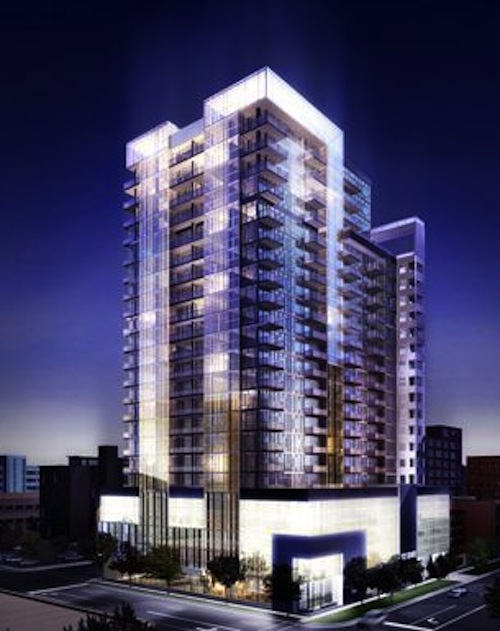
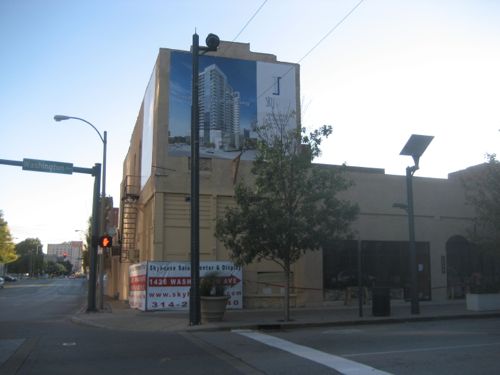
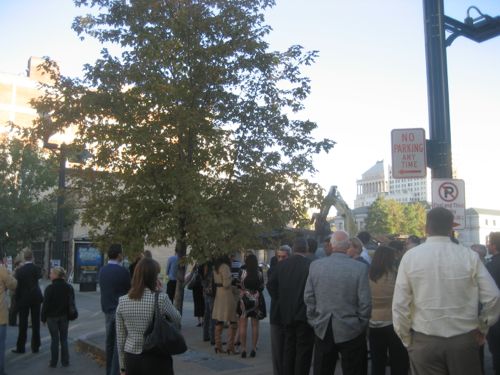
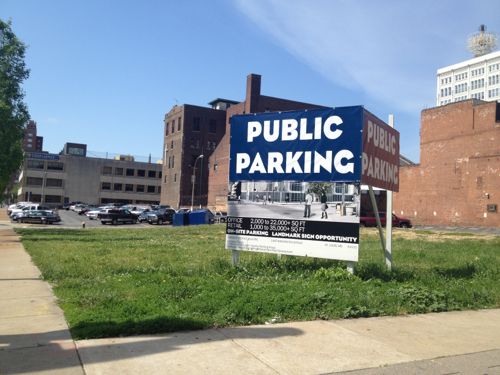
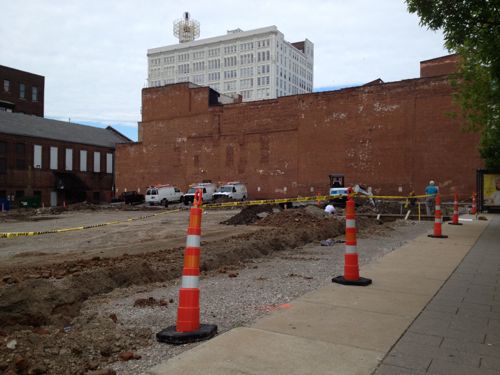
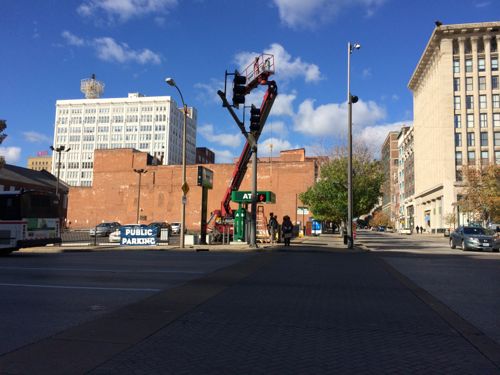
Surface parking is a good short-term land banking strategy. Now the land can bring in revenue until funding is fully in place for the next phase at this corner. I just hope that next phase begins within the next 5 years.
— Steve Patterson
A similar thing happened in south city, on Chippewa, where IHOP went away (west of Target) and the site is now a parking lot with an ATM.
In reality, these, along with Ball Park Village, are a microcosm / analogy for the larger city, they illustrate the hard reality of supply and demand. You can view them as “a good short-term land banking strategy” and “hope that next phase begins within the next 5 years”, but there seem to be way more low-intensity uses than high-density ones happening. We’ll all see what the next 5, 10, 15 and 20 years bring – I hope you’re right, but I have my doubts.
Commerce Bank put one of these things on Chip in South City where the old IHop used to be. An entire lot devoted to a drive-up island ATM surrounded by concrete. Dreadful.
edit – looks like JZ noticed the same thing.
A conversation with the manager awhile back had said that this particular iHop was going to be rebuilt as it was out-dated and at the end of it’s life. They were suppose to do it after they rebuilt the one near the Galleria. We were surprised when it came down, expecting another to be built. Then the ATM appeared. So I wonder if this is just temporary or if iHOP cancelled plans and sold the lot to the bank. It does seem to be a great waste of prime retail lottage.
But reading this blog over time, one picks up: Surface lots…bad, bad. Too much parking….bad, bad. And now their good. And yet SLU does land banking making lots into parks and they are damned to the hills. So maybe Biondi should have just paved everything.
Surface parking is bad in an urban context. In this case the corner has a much-needed walk-up ATM. The owner is still trying to build a new building, parking isn’t the final chapter.
But I plan to look at the design flaws of this parking lot very soon as well as how it is different from other surface lots.
I’m shocked, shocked I tell you, to see yet another “promising development” proposal go from hype to demolition to parking/vacant lot.
Once, just once, I would love to see the City say ‘no dice’ unless the developers have a bank note, plans, and contractors and subs lined up before one of these pointless demos occurs. The people of this City are being played for chumps by anyone with a shiny set of renderings, and the City management rolls over like a dog repeatedly when some flim-flam artist selling band instruments shows up in town. Either that, or they don’t do squat about property owners (the wealthier and better-connected especially; City cops included) with neglected structures in disrepair. This Skyhouse proposal, SLU’s ‘amulatory care center’ (SLU is finally–fiiiiiiiiinally–getting around to clearing the Pevely site, after a year of bupkuss; not surprising, with BFF’s like Roddy and Slay), Cupples 7, now Crunden-Martin, and likely many others matching the above examples. Having a corrupt set of incompetent toadies masquerading as public servants giving developers a helping hand is always a boon to civic progress, eh?
I wonder how many other parcels of land are sitting vacant after spurious development plans get ok’d by the City management units.
The city can’t just say “No!” to every demolition request. There’s this thing called private property RIGHTS, and if a property owner believes that HIS or HER land is more valuable with a parking lot than an old building, then the city needs some pretty damn good, legally enforceable, reasons for saying “No!” . . . . and just because you don’t like the way it will look is NOT a good enough reason!
The fact that I am a citizen is reason enough for me. As for property ‘rights’, my view is that we are caretakers of our ‘private’ property, and should not have the right to use it in any way we see fit. This is why we have laws against toxic and hazardous effluent. Why our skies are cleaner than they were fifty years ago. Why one can’t burn trash or leaves in the City (not that it hasn’t stopped a couple or three in my nabe). Why one can’t make your property into a shooting range, because you like guns (yet another person killed this week by an irresponsible property owner who thought that target practice on their ‘property’ was their “right”). Why we can’t turn our lawns into auto salvage yards. I could go on.
The system of property “rights” is heavily weighted towards those who have most of it anyway, even though they often possess it by means illegal and immoral.
Frankly, in light of the fact that every single hectare of land in N. and S. America was ‘owned’ by the people indigenous to this continent–and who were subsequently nearly eliminated by genocidal populations of immigrants–I find the modern notion of ‘property rights’ laughable.
We obviously disagree, but let’s take a shot at discussing your comments, anyways . . . . “The system of property “rights” is heavily weighted towards those who have most of it anyway” – yes, it is! The person/entity that has purchased a piece of property has likely spent significant dollars to do so, while you have spent none.
“They often possess it by means illegal and immoral” – By spending their hard-earned money? By working hard and being “successful”? Or do you view most property owners as just thieves and abusers of the “underclass”? Yes my grandparents and great-grandparents were immigrants (at the start of the 20th century), but they didn’t screw any indigenous peoples out of their land – they bought it from the people who OWNED it before them!
“The fact that I am a citizen is reason enough for me.” Agree and disagree – we all are entitled to our opinions, and we each get one vote. However, none of us gets a veto – community means working together, not throwing up irrational roadblocks. A vibrant community means making changes – we’re either getting better or we’re getting worse – nothing ever stays exactly the way it always was.
We do “not have the right to use it in any way we see fit.” Agree – we have the right to use it within the limits of established zoning regulations. Zoning does not and can not prohibit demolition for the simple reason that change needs to happen – buildings that are ready to fall down need to be torn down to protect the public’s health and safety. Buildings that need to be replaced need to be torn down, to improve the city.
The two real challenges, as Steve alludes to, are dedicating “urban” land to surface parking and land banking, in its several forms (vacant lots, surface parking lots, low-density suburban retail architecture, etc.), in a stagnant (struggling?) rust belt city and region. Density happens when land values are high, not because some government says “it must be”. The ONLY way government can create a dense development is to do it with their/our own money (tax dollars), either directly (in how we build public buildings) or through incentives (monetary, TIF, FAR, etc.).
New Town St. Charles didn’t happen because the county said it had to – the developer wanted to do it, for crass reasons – profit! The Central West End doesn’t stay dense and vibrant because of “the government”, it stays that way because people are willing to pay a premium to be there. And while certain unique neighborhoods deserve special protections from random demolitions, the city, as a whole, can’t become one large no-demolition-ever zone if we want to stay relevant in the region – Darwin had it right – adapt or die!
City planning has been a free for all for decades and the terrible results are easy to see in St. Louis. It has been shown capitalism does not in fact work except in a very limited sense. Private property rights are not unlimited. I fault the city government for not developing planning policies that every potential landowner has to submit to while making it clear what is expected. In any case, architecture and city planning are community arts and developers have obligations to the community.
Metropolitan Development Enterprises should not have been allowed to tear down any buildings if they were not ready to do the project. And, as a corollary they should have been required to maintain existing buildings in the mean time if they purchase them.
You always try to claim government has no role in development when there are examples all over the world where government in fact makes development more profitable and more desirable.
There are many examples, but one example is the Urban Growth boundaries of Portland that has helped transform that city into one of the most attractive in America.
The lassiez-faire approach you advocate has just about ruined St. Louis and if it doesn’t change the demise of the city as an attractive destination well be complete in a matter of time.
Free market capitalism is on the verge of destroying itself and humanity, the oceans are becoming barren of fish, the skies are polluted from fossil fuels, the Amazon rain forest is being decimated of easy to cut trees that are 100’s of years old. City planning in St. Louis is only one aspect of the sick results of what is essentially unbridled greed.
And we gloss over the fact that the population has exploded in the past century, but let’s blame it all on greed.
Much like Portland, Boulder established a de facto urban growth boundary in the 1970’s when they established their greenbelt system around the city. Short-term, it behaved as intended, limiting sprawl. Long-term, the law of unintended consequences kicked in, big time, with limited supply and increasing demand resulting in skyrocketing housing prices. Today, sprawl has leap-frogged the greenbelt, and many people working in Boulder can no longer afford to live there. Instead, they commute through the greenbelt every day, in their much-longer commutes between home and work.
I have never advocated a lassiez-faire approach to urban planning. We need to guide how and where growth occurs, but we also cannot simply tell people that they must maintain every old building, at any and all costs, and that cars must simply go away. There needs to be a middle ground, one that balances regulations with economic realities.
I guess our biggest point of disagreement is the definition of success. You seem to be focused on maintaining the “traditional”, 19th Century built environment as the biggest indicator of “success” while I view economic success as the best indicator. The more people want to be some place, the more economically diverse and vibrant it will be. Land values will increase, driving both density and walkability.
The big reason we’re seeing ever-increasing sprawl in and around St. Louis, even in the traditional urban core, has very little to do with bad governing and way more to do with incredibly cheap land values, especially compared to those European cities you hold out as better examples. The core areas of Helsinki are seeing land values of 5,000-6,000 euros per square meter – http://yle.fi/uutiset/helsinkis_preposterous_property_prices/6468761 . . which translates to to $640-$770 per square foot. Compare that to what’s available here – one prime example, at Manchester & I-270 is being offered for $6.50 / sq. ft. – http://www.loopnet.com/Listing/18351704/1-Bedrock-Saint-Louis-MO/ . . another near Lacede’s Landing is on the market for $33.67 / sq. ft. – http://www.loopnet.com/Listing/18259813/612-North-1st-Street-Saint-Louis-MO/ . . When land values are 20-100 times greater than they are here, yes, density and quality will happen . . . .